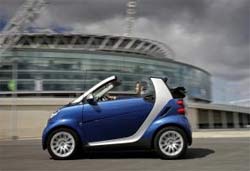Daimler micro car Smart updates its model range
16 July 2008
Daimler AG plans to upgrade the standard equipment of the 45 kW/61 bhp and 52 kW/71 bhp petrol-engined Smart fortwo models.
It will introduce micro hybrid drive (mhd) technology with a user-friendly automatic start-stop system in both models. This technology helps reduce the NEDC consumption of the two naturally aspirated engines by an average of 8 per cent, which can result in fuel savings of almost 20 per cent in city traffic. The upgradation will be effective from October 2008, according to the German automaker.
 The auto maker also said that it will introduce a closed-diesel particulate filter that almost completely eradicates particulate emissions in the the Smart fortwo cdi version this year. The equipment of the innovative two-seater is being upgraded by an instrument cluster with a new design featuring an enhanced instrument panel and new door net pockets among other things. Two new colours "grey metallic" and "rally red" would be a new addition along with the optional new sporty six-spoke alloy wheels.
The auto maker also said that it will introduce a closed-diesel particulate filter that almost completely eradicates particulate emissions in the the Smart fortwo cdi version this year. The equipment of the innovative two-seater is being upgraded by an instrument cluster with a new design featuring an enhanced instrument panel and new door net pockets among other things. Two new colours "grey metallic" and "rally red" would be a new addition along with the optional new sporty six-spoke alloy wheels.
Daimler says it is is resolutely continuing its philosophy of making the smart fortwo even more environmentally-friendly and attractive by further reducing consumption and upgrade the vehicle's comfort levels for even better overall driving pleasure.
The Smart micro hybrid drive (mhd) automatic start-stop function has proven itself since 2007, although to date it has only been available in the 52kW/71 bhp model. To reduce the fuel costs for the smart fortwo, the two petrol models with 45 kW/61 bhp and 52 kW/71 bhp engines are now being fitted with the start-stop automatic function as standard (except in the US and Canada). This reduces the consumption of both versions in the combined cycle by around eight per cent, with a significant reduction in CO2 emissions.
Smart has realised the idea behind the automatic start-stop system in a particularly clever way: the control electronics shut down the engine as soon as the driver brakes and the vehicle's speed falls below 8 km/h - for example when approaching traffic lights.
